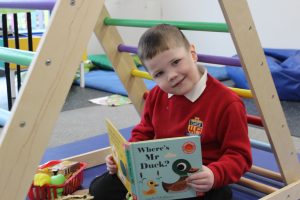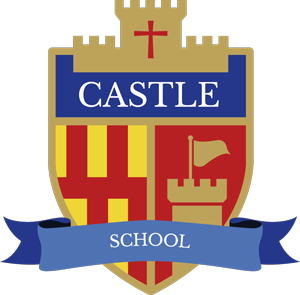Children become readers from the moment they learn to love books and stories at an early age. At Castle School, we promote a love of reading and actively encourage this across school on a daily basis. Reading is shared or independent depending on the ages and needs of the pupil.
Literacy for All
In Castle School we will deliver a literacy curriculum that is accessible to all. Our curriculum is mindful of each pupil’s individual needs and learning styles and recognises the need for a multi modal-approach (such as signing and symbols), supported by a range of multi-sensory activities to foster understanding and enjoyment of books, stories, plays and poems.
The semi-formal curriculum will develop the early stage of reading and writing and will foster learning that is repetitive in order to gain concrete skills. Pupils will have the opportunity to gain early memory and thinking skills in order to sequence and retell texts. Pupils will be supported to enhance early writing skills, including gross and fine motor. Phonics will be developed, and skills taught to support learners early reading skills.
These aims are embedded across our ‘my communication’ sessions and the wider curriculum. We will provide purposeful opportunities for reading, writing and discussion. We will use a wide variety of text and resources to motivate and inspire our children. Teacher’s also ensure that cross curricular links with topics and themes are woven into the programmes of study.
Developing independent thinking
The formal curriculum will encourage pupils to become independent readers and writers and to develop individual opinions based on a wide genre of texts. Pupils will be able to read high frequency words fluently. They will have access to a higher-level reading scheme, as well as developing reading for pleasure. Pupils will access writing activities that develop their creative skills.
Our children and young people will foster a love of literacy in stories, poems, books and drama and will be enabled to access these as independently as possible. They will develop their skills of communication and the reading and writing processes to the best of their ability. Literacy will be taught not only in discrete lessons but across everything we do encouraging learners competence in both functional and creative situations in their adult life.
Phonics
Essential Letters and Sounds
In Castle School this year we have moved to Essential Letters and Sounds for our more Formal Pathway learners and those children we feel are ready for phonics teaching. Essential Letters and Sounds is a phonics programme based on Letters and Sounds (2007). This phonics programme will support your child in making progress to become a more fluent and confident reader.
The aim of ELS is ‘Getting all children to read well’. It teaches children to read by identifying
the phonemes (the smallest unit of sound) and graphemes (the written version of the sound)
within words and using these to read words.
ELS is explicitly taught every day during a dedicated slot on the timetable. Children are given
the knowledge and the skills to then apply this independently.
Throughout the day, children will use their growing Phonics knowledge to support them in
other areas of the curriculum and will have many opportunities to practise their reading.
We follow the ELS progression and sequence. This allows our children to practise their
existing phonic knowledge whilst building their understanding of the ‘code’ of our language
GPCs (Grapheme Phoneme Correspondence). As a result, our children can tackle any
unfamiliar words that they might discover.
Children experience the joy of books and language whilst acquiring the skills they need to
become fluent independent readers and writers. ELS teaches relevant, useful and ambitious
vocabulary to support each child’s journey to becoming fluent and independent readers.
We begin by teaching the single letter sounds before moving to diagraphs ‘sh’ (two letters
spelling one sound), trigraphs ‘igh’ (three letters spelling one sound) and quadgraphs ‘eigh’
(four letters spelling one sound).
We teach children to:
- Decode (read) by identifying each sound within a word and blending them together to read fluently
- Encode (write) by segmenting each sound to write words accurately.
The structure of ELS lessons allows children to know what is coming next, what they need to
do, and how to achieve success. This makes it easier for children to learn the GPCs we are
teaching (the alphabetic code) and how to apply this when reading.
ELS is designed on the principle that children should ‘keep up’ rather than ‘catch up’. Since
interventions are delivered within the lesson by the teacher, any child who is struggling with
the new knowledge can be immediately targeted with appropriate support. Where further
support is required, 1:1 interventions are used where needed. These interventions are short,
specific and effective.
Supporting Reading at Home:
- Children will only read books that are entirely decodable, this means that they should be able to read these books as they already know the code contained within the book.
- We only use pure sounds when decoding words (no ‘uh’ after the sound)
- We want children to practise reading their book 4 times across the week working on
these skills:
Decode – sounding out and blending to read the word.
Fluency – reading words with less obvious decoding.
Expression – using intonation and expression to bring the text to life
We must use pure sounds when we are pronouncing the sounds and supporting children in reading words. If we mispronounce these sounds, we will make reading harder for our children. Please watch the videos below for how to accurately pronounce these sounds.
More support for parents and carers can be found here:
https://home.oxfordowl.co.uk/reading/reading-schemes-oxford-levels/essential-letters-and-sounds/
Phase 2 Sounds
Phase 3 Sounds




